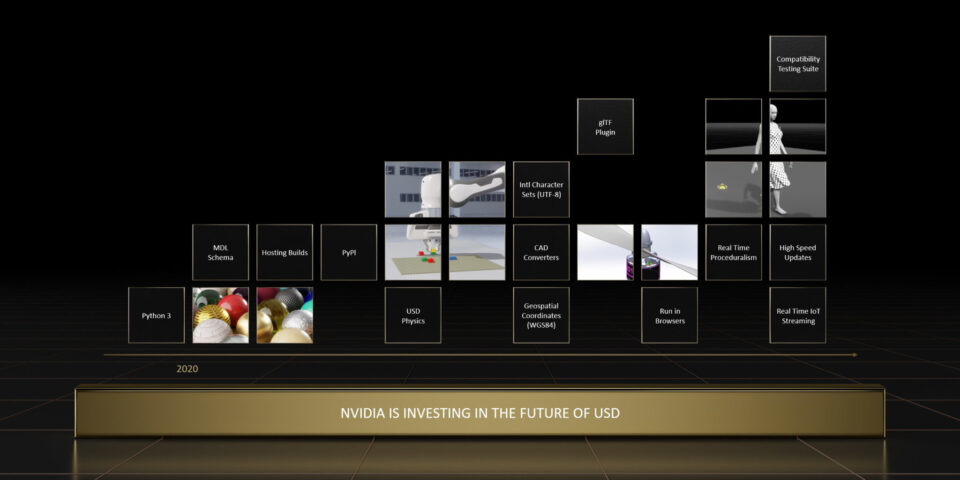Nvidia announces plan to ‘evolve USD beyond VFX’
Nvidia has announced ambitious plans to expand the capabilities of Universal Scene Description (USD) beyond visual effects and into industries like architecture, engineering and manufacturing.
The firm hopes that by enabling USD, currently mainly used to exchange data between DCC applications, to represent a broader range of content, it will “become a foundation of the open metaverse and 3D internet”.
Nvidia will “pursue a multi-year roadmap” in partnership with firms including Autodesk and Siemens, bringing together “hundreds of engineering and product leads” to identify development priorities.
The announcement was made during Nvidia’s special address at Siggraph 2022, along with updates to Omniverse and NeuralVDB, the ‘next evolution’ of OpenVDB.
Moving from entertainment to AEC
Developed in-house at Pixar and open-sourced in 2016, USD was originally designed as a way to exchange scene data between the software applications used in VFX and animation pipelines.
The first hint that it could become something more was when Nvidia announced that Omniverse, its online platform for design collaboration, would be built around the format.
While Omniverse is also intended for entertainment work, a major part of its target audience is architecture and engineering, with the platform now adopted by firms including BMW, Ericsson and Lockheed Martin.
The equivalent of HTML for the metaverse?
At Siggraph, Nvidia went further, proposing USD as the “foundation of the open metaverse”, with a role equivalent in the development of a 3D internet to that of HTML in the development of the World Wide Web.
It now aims to expand USD’s capability to represent objects from the real world as well as the imagination.
“Without a representation of the things that can exist in the metaverse, the metaverse cannot exist,” said Rev Lebaredian, vice president of Omniverse and simulation technology at Nvidia.
“Working with our community of partners, we’re investing in USD so that it can serve as the foundation for architecture, manufacturing, robotics, engineering and many more domains”
The power to influence, but not dictate, future developments
Exactly what changes that will require to USD – or to what extent they will be welcomed by its other users – is less clear.
Despite the recent establishment of a Metaverse Standards Forum, there’s currently no firm consensus of what form the metaverse should take.
Nvidia’s own conception of it is simply a “3D overlay of the internet” – interacting online via 3D graphics rather than 2D images – rather than the more virtual-reality-focused version proposed by Meta last year.
In addition, as an open-source technology, USD isn’t directly controlled by Nvidia.
However, Nvidia does have considerable influence among the the tech companies that contribute to its development – or that might do so in future – and a considerable budget to fund that development.
Nvidia’s roadmap for USD development: some of the firm’s planned future investments in extending Universal Scene Description to new industries. Click on the image to view it at full size.
So what changes to USD can we actually expect?
On that first point, Nvidia says that it is bringing together “hundreds of engineering and product leads” into working councils at Siggraph to identify future USD development priorities.
Partners namechecked in its announcement include Siemens and Autodesk – which, as the developer of both CAD tools like AutoCAD and DCC tools like Maya, straddles the present and proposed future of USD.
On the second point, Nvidia released a slide showing “examples of [its] planned investments” in USD, along with an accompanying blog post setting out its roadmap in more detail.
Upcoming developments include glTF interoperability, in the shape of a new plugin that will enable glTF assets to be referenced by USD scenes, and support for the WGS84 standard for geospatial data.
Long-term goals include real-time proceduralism, real-time streaming of data from Internet of Things (IoT) devices, and even compatibility with web browsers, raising the possibility of viewing USD data natively in Chrome or Firefox.
Read Nvidia’s announcement of its intention to extend USD beyond entertainment work

